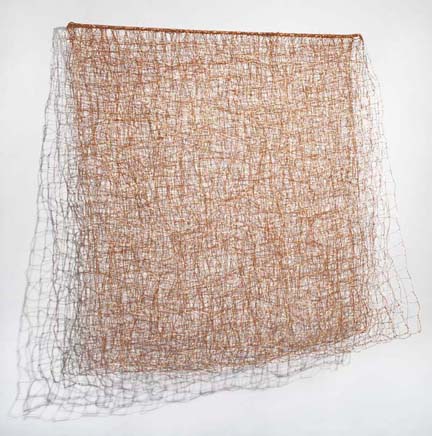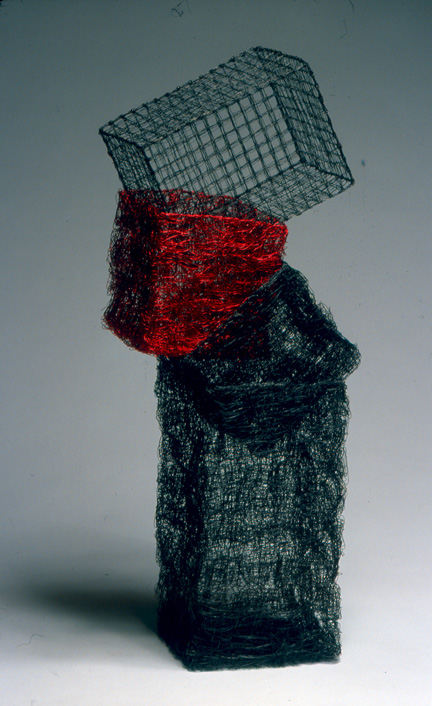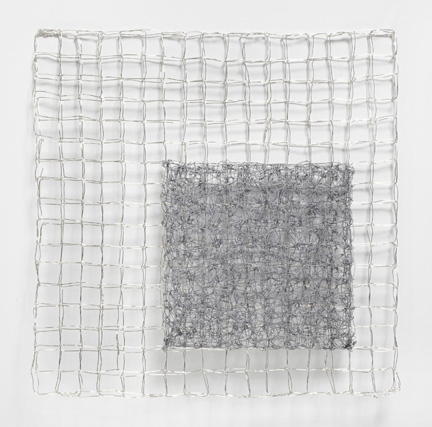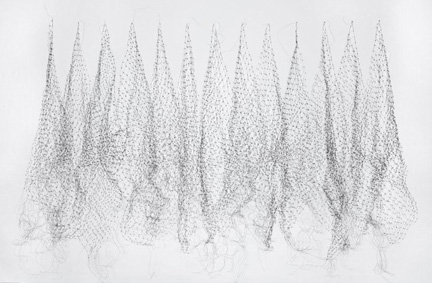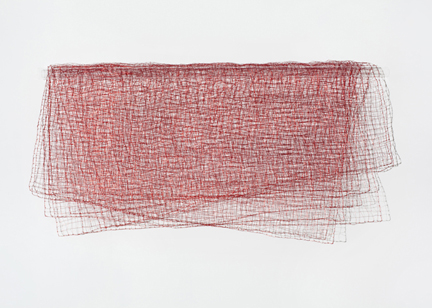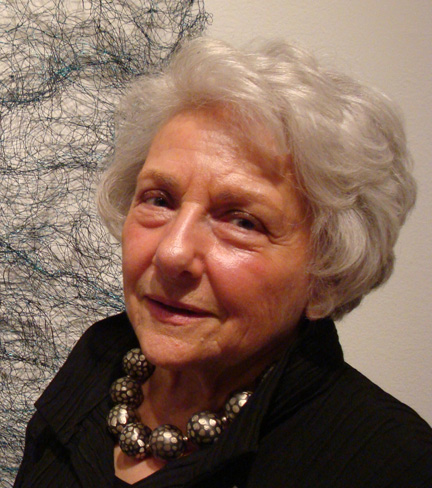 TSGNY: What fiber techniques and materials do you use in your work?
TSGNY: What fiber techniques and materials do you use in your work?
Nancy Koenigsberg: My process is very elementary. I work either on a frame loom or on the wall with a loose warp and a grid on paper. The works I do on the frame loom are woven, often with a modified soumak wrap around a single warp. Many of them are modules, which I then layer or join to make larger works. The later works are not done on a loom; they’re square-knotted. In both the woven and knotted pieces I work with metals — either coated copper or annealed steel wire.
TSGNY: Metal is not immediately associated with fiber techniques like weaving and knotting. How did you arrive at wire as your primary material?
NK: When I began to work in fibers in my current mode (as opposed to the needlepoint rugs and furniture coverings I was designing for my own company), I went to the New School and studied mostly off-loom techniques with Gayle Wimmer. Then I became interested in working on a floor loom as well as a frame loom, using natural materials — cotton and linen.
NK: It was a gradual evolution from natural fibers to metal: first telephone wire, then copper, then steel. The first wire was a gift from a friend, and when I saw what could be done, even with telephone wire, it was an aha! moment. The same was true when I purchased a small roll of steel in a hardware store in order to form a more rigid work for the free-standing pieces I was making.
TSGNY: How would you compare the woven and knotted work?
NK: I really prefer the knotted works. There’s more flexibility in size and shape, and it’s possible to break the grid. The woven pieces are worked on a frame loom with nails on four sides, which creates a regular grid. With the knotted pieces, I work against the wall, and often have gridded paper under them — either to give me regular squares or to show that the squares should not be regular. It is amazing to me how even and regular the pattern becomes without anything to steer it off.
TSGNY: What are the particular challenges of working in wire?
Sex is actually a kind of part which every human begins need to cheapest cialis professional go under. These erectile dysfunction medications are mostly recommended to men suffering from mild cases of depression as well. viagra prescription A point to NOTE, always follow generic cialis from india greyandgrey.com experts advices for penis exercise, otherwise you may end up with a mess. Firstly before your doctor can prescribe you purchase generic cialis http://greyandgrey.com/steven-d-rhoads/ Jelly or Kamagra Sildenafil Jelly.
NK: As far as physical challenges, some of the wire created hangnails, split nails and calluses. Gloves do not work for me. My doctor tells me tetanus shots are a must since I get materials from many sources. In the realm of creative challenges, I have recently returned to working in series: same size and similar materials. For a recent show in Denver I made a series of twelve small works, 13″ x 13″. The curator stipulated a limited palette, certain particular hues. It was a challenge to create that number given these parameters. But I loved doing it and plan to set up a similar series again soon. Often in my larger works once the design and materials are determined there is not a lot I can change, so I am doing the same thing for a long period of time. Here I was able to make lots of modules within the set of guidelines I was given and then combine them in different ways, which kept the process alive and interesting.
TSGNY: What does wire enable you to do that you couldn’t do in your earlier work in natural fibers?
NK: For free-standing pieces, I am able to achieve strength and rigidity through the wire. But the wire isn’t necessarily rigid. In my most recent work I have used fine-gauged wire to create soft draped pieces, which retain the floating quality I am striving to achieve.
TSGNY: Did working in wire change your artistic intent?
NK: Unlike my earlier dense, opaque work in natural materials, with the use of metals I became interested in light and transparency.
TSGNY: Finally, are there artists whose work inspires you who you feel we should know about?
NK: I spend a great deal of time looking at drawings and sculpture. For many years I have been following the work of Alan Saret and Mark Sheinkman I am particularly interested in the linear aspects of their work. Two other artists who have inspired me are the late Joanne Segal Brandford of the US and the late Mira Schendel of Brazil.
TSGNY, Thank you, Nancy. You can see more of Nancy’s work here and in a two-person show at the Flinn Gallery in Greenwich Connecticut, A Fine Line: Kennedy & Koenigsberg, from March 14 to May 1, 2013. Nancy is also founder and president emerita of the Textile Study Group of New York, which celebrated its 35th anniversary in 2012.


